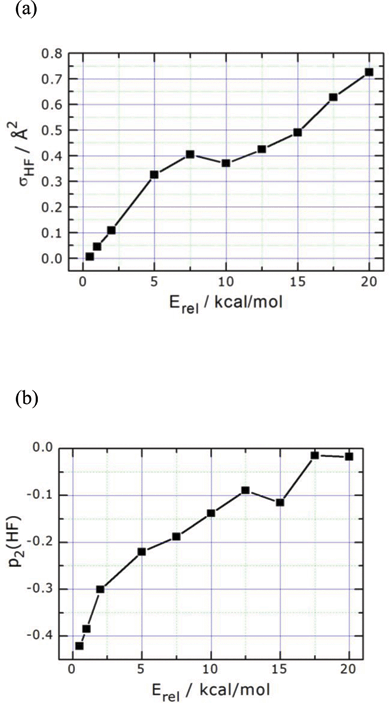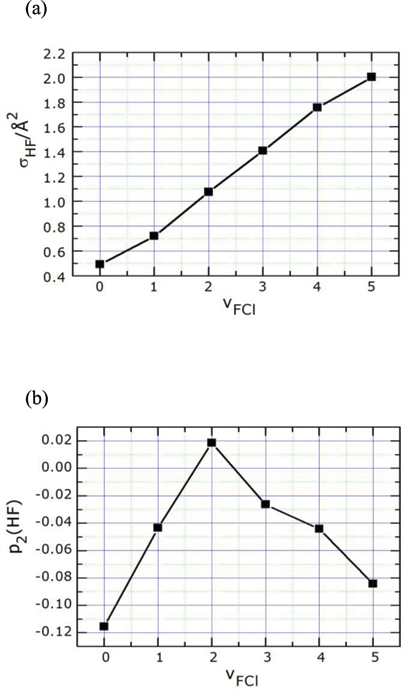
Additions and corrections
Product rotational angular momentum polarization in the H + FCl(v = 0–5, j = 0, 3, 6, 9) → HF + Cl reaction
Victor Wei-Keh Wu
Phys. Chem. Chem. Phys., 2012, 13, 9407–9417 (DOI: 10.1039/c0cp02416c). Amendment published 27th July 2012.
The integral cross sections and alignments dependent upon the relative collision energies shown in Fig. 9a and 9b, respectively; those dependent upon the rotational states of FCl(v = 0, j = 0, 3, 6, 9) given in Table 1; vibrational states of FCl (v = 0–5, j = 0) shown in Fig. 10a and 10b, with the respective values given in Table 2 and 3 are for H + FCl(v = 0–5, j = 0, 3, 6, 9) → HCl + F reaction, instead of the title reaction H + FCl(v = 0–5, j = 0, 3, 6, 9) → HF + Cl. The correct curves and values for the title reaction are given in the following Fig. 9a, 9b, 10a, and 10b, Tables 1, 2 and 3. The related descriptions and explanations in the paper are also revised.
In page 9410 left bottom, the given equation is to be corrected as:

In page 9411 left, the 4th line, it should be “...(1/σ)(dσkq±/dωt) is the PDDCSs”. In page 9411 right above, the description should be: “In case (a), the optimized maximum impact parameters are e.g. 2.855, 2.308 and 2.4 Angstroms for 5, 10 and 15 kcal mol–1, respectively (Table 2). In case (b), ... the optimized maximum impact parameters are 2.503, 2.7, 2.8, 2.85, and 2.97 Angstroms, respectively (Table 3). In case (c), ... the optimized maximum impact parameters are 2.25, 2.22 and 2.22 Angstroms, respectively (Table 1).”
In page 9415 right above, it should be: “...increases from approximately zero to 0.7 Å2 as the relative scattering energy Erel increases to 20 kcal mol–1 (Fig. 9a, and Table 2). The corresponding rate constant 1.41 x 10–12 [cm3 mol–1 s–1] for 298 K from the... However, the integral cross section around 0.38 Å2 at Erel = 8.5 [kcal mol–1] can be interpolated... The discrepancy between the integral cross sections 0.38 Å2 from our calculation, and ... The product molecule HF is comparably strongly aligned with p2 around –0.11 for the reactions at collision energy of 10–15 kcal mol–1 (Fig. 9b, Table 2). ... increase from σHF = 0.5 to 2.0 Å2 with νFCl = 0 to 5, ... The alignment is generally weak with p2 = –0.12 if ν = 0; it reduces to 0.02 for ν = 2, then goes to –0.08 at ν = 5.”
In page 9416 left below, it should be: “…It runs to 0.7 Å2. ... from 0.5–2.0 Å2 for ν = 0–5, respectively, at Erel = 15 kcal mol–1. ... strongly aligned with p2 = –0.12 for ν = 0 of FCl ... reduces to p2 = 0.02 as the vibrational state is increased to ν = 2, then runs to p2 = –0.08 at ν = 5.”
Table 1. Distributions of impact parameters bmax, numbers of reactive trajectories nHF, integral cross sections σHF, and alignments p2 (⟨j′·k⟩) for the product molecule HF, dependent upon the rotational states j, at the relative scattering energy 15 kcal mol–1, with 10 000 batches, for the reaction H + FCl(v = 0, j = 0, 3, 6, 9) → HF(v′, j′) + Cl
| v′ | j′ | bmax/Å | nHF | σHF/Å | p2 |
|---|---|---|---|---|---|
| 0 | 0 | 2.4 | 271 | 0.4904 | –0.1156 |
| 0 | 3 | 2.25 | 341 | 0.5423 | –0.0487 |
| 0 | 6 | 2.22 | 349 | 0.5404 | –0.0728 |
| 0 | 9 | 2.22 | 347 | 0.5373 | –0.0987 |
Fig. 9. (a) Distribution of integral cross sections of product molecule HF of H + FCl(v = 0, j = 0) → HF(v′, j′) + Cl at Erel = 0.5–15 kcal mol–1. (b) Distribution of alignments of the product molecule HF of H + FCl(v = 0, j = 0) → HF (v′, j′) + Cl at Erel = 0.5–15 kcal mol–1

Table 2. Distributions of impact parameters bmax, numbers of reactive trajectories nHF, integral cross sections σHF, and alignments p2 (⟨j′·k⟩) for the product molecule HF, dependent upon the relative scattering energies 0.5–20 kcal mol–1, with 10 000 batches, for the reaction H + FCl(v = 0, j = 0) → HF(v′, j′) + Cl
| Erel/kcal mol– | bmax/Å | nHF | σHF/Å | p2 |
|---|---|---|---|---|
| 0.5 | 1.5 | 7 | 0.00495 | –0.4216 |
| 1.0 | 1.9 | 39 | 0.04423 | –0.385 |
| 2.0 | 2.0 | 86 | 0.10807 | –0.3008 |
| 5.0 | 2.855 | 127 | 0.32521 | –0.2207 |
| 7.5 | 2.95 | 148 | 0.40463 | –0.1884 |
| 10.0 | 2.308 | 221 | 0.36984 | –0.1383 |
| 12.5 | 2.2325 | 271 | 0.42433 | –0.0896 |
| 15.0 | 2.4 | 271 | 0.49039 | –0.1156 |
| 17.5 | 2.24 | 398 | 0.62738 | –0.0151 |
| 20.0 | 2.24 | 460 | 0.72511 | –0.01755 |
Fig. 10 (a) Distribution of the integral cross sections σHF of H + FCl(v = 0–5, j = 0) → HF(v′, j′) + Cl, by the vibrationally enhanced FCl at Erel = 0.5–15 kcal mol–1. (b) Distribution of alignments p2 of the product molecule HF of H + FCl(v = 0–5, j = 0) → HF(v′, j′) + Cl, by the vibrationally enhanced FCl at Erel = 0.5–15 kcal mol–1.

Table 3. Distributions of impact parameters bmax, numbers of reactive trajectories nHF, integral cross sections σHF, and alignments p2 (⟨j′·k⟩) for the product molecule HF, dependent upon the vibrational states v, at the relative scattering energy 15 kcal mol–1, with 10 000 batches, for the reaction H + FCl(v = 0–5, j = 0) → HF(v′, j′) + Cl
| v′ | bmax/Å | nHF | σHF/Å | p2 |
|---|---|---|---|---|
| 0 | 2.4 | 271 | 0.4904 | –0.1156 |
| 1 | 2.503 | 365 | 0.7184 | –0.0436 |
| 2 | 2.7 | 469 | 1.0741 | 0.0185 |
| 3 | 2.8 | 571 | 1.4064 | –0.0264 |
| 4 | 2.85 | 688 | 1.7556 | –0.0443 |
| 5 | 2.97 | 722 | 2.0008 | –0.0843 |
The Royal Society of Chemistry apologises for these errors and any consequent inconvenience to authors and readers.
Back to article